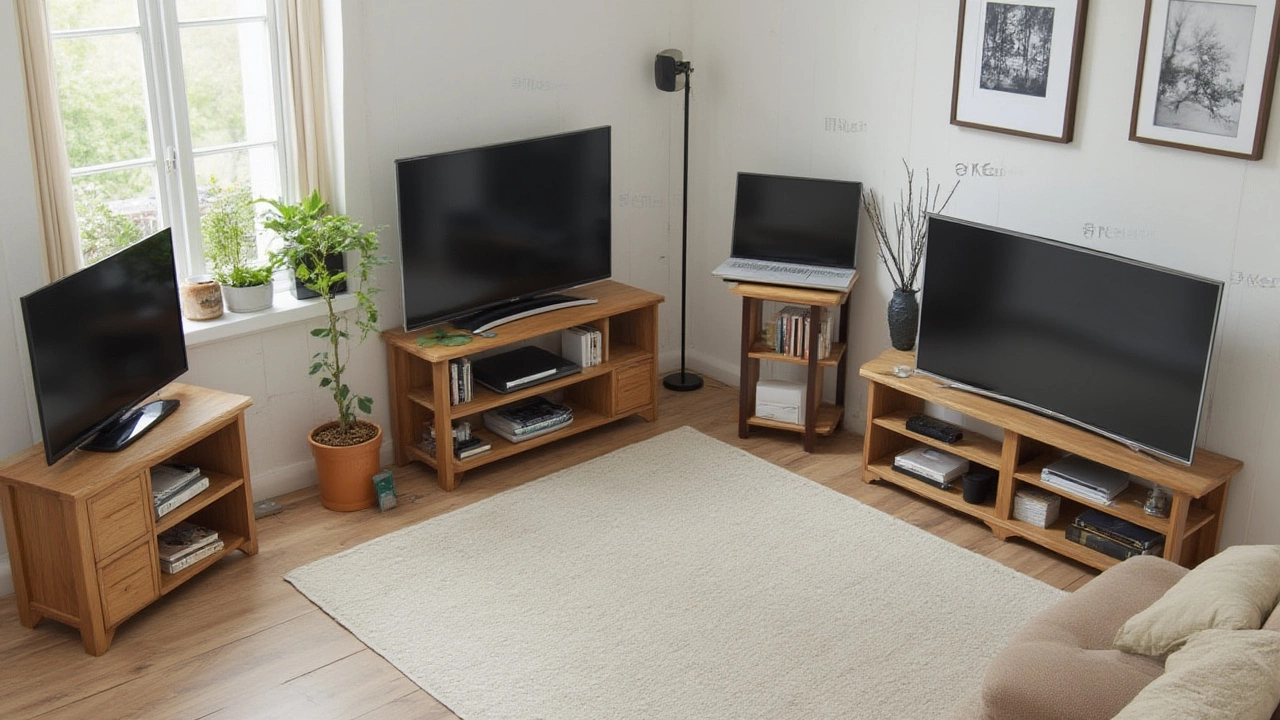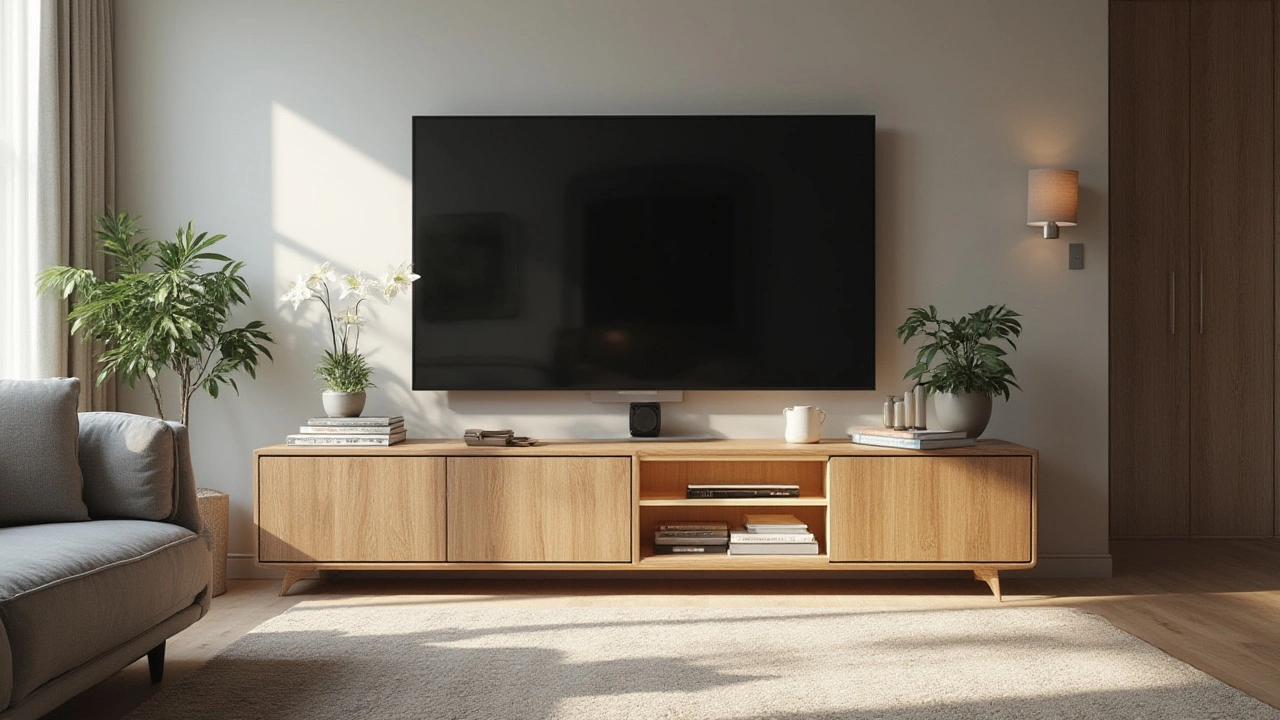You’ve just finished unboxing your new TV, and the next problem rears its head: your TV stand. Should it be bigger, smaller, or the exact width as your screen? It’s not just about looks—it’s about safety, symmetry, and style. Picture your fresh 55-inch telly balancing on an undersized shelf; it’s a recipe for those late-night knocks and accidental bumps. In Birmingham, where clever use of smaller living spaces is a way of life, this question is as practical as it is decorative. Turns out, there’s some solid logic—and more than a few design secrets—behind the right answer.
Why TV Stand Size Actually Matters
Most people pick a TV stand on impulse, maybe chasing a deal or the colour that matches their sofa. But the numbers behind this choice speak volumes. A TV stand does two big jobs: holding your telly steady and framing it for the best look in your space. Let your stand be too skinny, and you risk a television teetering over the edge—never a good look (or safe, especially if you have kids or pets running about). According to Home Safety UK, TVs toppling off narrow stands cause over a thousand injuries a year—and that’s just in the last twelve months. Most furniture and home stores now recommend picking a stand at least 10cm wider on each side than your TV, making it at least 20cm wider overall. So, if you’ve got a 50-inch telly (about 112cm wide including bezels), you’ll want a TV stand close to 130-140cm in width.
The logic isn’t just about stability. That bit of extra width helps keep remotes, soundbars, or your favourite football mug from sliding to the floor. It also keeps cables tidy and out of sight, especially if your stand comes with built-in management at the back. Most modern TVs have a base in the middle rather than feet at each edge, but even with these, you want ‘wiggle room’ for centering your screen. Ever noticed how crooked TVs look in a room? It’s all wonky angles and off-balance vibes when the stand is too small. That sense of visual balance actually affects how comfortable we feel watching telly—there’s a reason designers fuss over symmetry. Designers surveyed by Interiors UK in late 2024 said that over 80% of living rooms look ‘significantly more cohesive’ with a stand at least as wide as the TV, if not a touch wider.
Another thing people forget: stands also bear the weight of everything you stack on them, from consoles to players to stacks of cookbooks (for those kitchen TVs). Most stands under 20-30kg max weight aren’t built to hold much, yet a big flat-screen can easily weigh 15kg or more. Good modern wooden or metal units often handle 40kg, giving space for extras. Some cheap, lightweight stands might flex or buckle with the added weight, so always check the specs. Bonus tip: heavy TVs with narrow feet actually shift the centre of gravity forward. The stand needs to balance that, or you’ll risk the whole thing tumbling.
If you’re thinking about wall-mounting your telly, you still want a cabinet underneath that’s at least as wide as the screen. Not only does it look finished, it gives you space for kit, decor, and catches cords so your wall doesn’t end up looking like spaghetti junction. A study by the Furniture Industry Research Association showed homes with wider stands (even under wall-mounted TVs) looked more ‘complete’ and had fewer visible trip hazards thanks to better cable control.

Style, Proportion, and The Odd Psychology of TV Furniture
Aesthetics matter just as much as safety. Ever walked into a living room where the TV dwarfs the furniture, making everything else look tiny? Or, just as bad, where a massive unit swamps a compact TV? There’s an ideal “sweet spot” that makes the whole room feel intentional and comfortable. Interior stylists often talk about the “golden ratio” (about 1.6:1) as the most pleasing proportion, but real-world choices are simpler: match your TV stand width to be just wider than your TV, up to 1.2 times the screen width if you have the space. For folks in the UK with narrower lounge walls and flat conversions, the look of balance makes even small spaces feel properly put together.
Practicality comes into play, too. A stand that’s bigger than your TV gives you room for speakers, lamps, or those impulse-buy plants from the local market. TV stands often double as storage these days, hiding away games, wires, or those rogue batteries that go missing whenever you need them. In a 2025 poll of first-time homeowners in the Midlands, 62% listed ‘extra hidden storage’ as the main reason for picking a TV unit bigger than their screen. The best stands use clever shelving or sliding doors to tame visual clutter.
The psychology bit is real, too. Having a TV perched on a tiny stand makes people nervous—even if you don’t have kids or cats with a talent for chaos. Wider stands look grounded and substantial, which has a calming effect. You’ll notice it when you walk into well-designed hotel lobbies, waiting rooms, or posh show flats—screens are always framed by furniture that feels solid and generous. As for décor, it’s a lot easier to make your TV setup look intentional when you’ve got extra surface to play with: stack your favourite hardbacks, cluster candles, or make use of decorative trays to anchor the setup. Not just nice to look at, but handy when you need somewhere to drop your keys at the end of the day.
Some design rules for picking out a TV stand for your space:
- Measure your TV—remember, screens are measured diagonally, but stands are measured by width. Don’t mix up the numbers.
- Check the full width of the TV (including the frame or bezel) before you shop for stands.
- Choose a stand at least as wide as your TV. An extra 10-20cm creates the perfect margin for most homes.
- If you’re short on space, pick a stand that’s almost as wide as the TV, but no smaller, or anchor narrower stands to the wall for safety.
- If you’re going big—like a 75-inch telly—think “media unit” rather than just a table. Modular units can stretch an entire wall and become a focal point.
- Style with intention: balance out your telly on the stand with objects at either side, and keep mess tucked away in drawers or baskets.
It’s also worth thinking about height. The perfect stand puts the centre of your TV screen at eye level when you’re sitting—roughly 110-120cm from the floor, depending on sofa height. Ever ended up with neck ache because your telly’s too high or too low? You’re not alone. Statistically, over half of UK homeowners admit to having to “adjust” their seating to get a better TV angle. So stand height matters, nearly as much as width.

Real-World Picks: Matching Stand Type, TV Size, and Room Layout
Shopping for a new TV stand can be overwhelming—heaps of styles, all those measurements, and the pressure to get it right. Don’t fret, though. It helps to start with a shortlist that considers TV size, room layout, and your own storage needs. Let’s break it down with some examples and data that can spare you the rookie mistakes.
Take a look at this handy table:
| TV Screen Size | Typical TV Width (cm) | Recommended Stand Width (cm) | Minimum Weight Capacity |
|---|---|---|---|
| 32" | 73 | 90-100 | 15-20kg |
| 43" | 97 | 115-130 | 20-25kg |
| 50" | 112 | 130-140 | 25-30kg |
| 55" | 123 | 140-150 | 30-35kg |
| 65" | 145 | 165-180 | 35-40kg |
Where you put the stand is just as important as what you pick. If the unit’s going in a corner, you might look for specially shaped stands that fit snug but still offer a wider footprint than the screen. For big, open-plan lounges, long, low-profile consoles keep things neat—plus you can add boxes or baskets underneath for bonus storage. If your living room doubles up as your cinema room (Friday movie nights, anyone?), go for a closed unit to muffle speaker wires and hide any clutter. For renters or anyone who might move soon, choose featherweight but sturdy stands that break down easily. Flat-pack options aren’t just for students—modern versions often come with cable holes, soft-close doors, and adjustable shelving.
Since 2022, sales of modular TV cabinets and wall units have climbed, with IKEA’s Besta and Argos’s Malibu ranges flying off shelves. Birmingham’s city centre flats, already tight on space, often need stands that double up as storage—you’ll see loads of combination bookcase-media units along the Hagley Road. And don’t forget adjustable feet: slightly uneven floors in older houses need these to keep your kit wobble-free. In homes where space is at a premium, using the full footprint of a wall isn’t just stylish—you’ll reclaim floor space and keep things looking less cluttered.
For those keen on style, Scandinavian-inspired pale woods and simple lines are still topping the trends. But Brits also love a classic dark oak or walnut effect for a cosier vibe. For those with ultra-modern LED TVs, glossy stands with glass fronts or smoked glass shelves remain popular. Mix and match depending on whether you want your stand to blend in or make a statement. Either way, the common rule stands: pick a TV stand size that’s wider than your telly for looks and safety both. Trying to squeeze a massive screen onto a narrow stand—no matter how good the price—is always a false economy.
Here’s a quick checklist to wrap up:
- Measure both your TV and your available space. Check width and depth, not just diagonal.
- Prioritise a stand width 10-20cm wider than your TV for safety and balance.
- Check the weight rating, especially for larger screens and added kit.
- Think about storage—drawers, cupboards, and shelves help keep everything tidy.
- Choose a finish and style that suit your space, whether you want your setup to stand out or blend in.
- Remember, looks and function go together—a stand that’s too small or too big just feels off.
Don’t let the final step be an afterthought. A little extra width for your TV stand pays you back in peace of mind, safer evenings, and a lounge that looks sharp—that’s why all the experts, and honestly, most who’ve ever stubbed a toe on a corner, agree: your TV stand should always be a bit bigger than your TV.


Write a comment